The Grand Tour, One Last Time
December 11, 2017
It has been while since posting. No excuses, no writers’ block, just taking a break.
So we decided to take a real break and tour some of our favorite places in Europe. We decided to go in the late fall to avoid the crowds. And that worked out for a about half of our tour. When on our last visit, there was a 2 kilometer line to get into the Vatican Museum, this time we walked right in with no waiting. When there was a 4 hour line to get into the Ufizzi Gallery in Florence (which we declined and never got to visit one of the world’s great museums) , this time there was no line at all. And the weather was clear and in the 50s and 60s. So, visiting Italy? Late November is about as good as it gets.
Austria in early December is another story. Just around freezing every day and lots of snow in the mountains and our last day in Vienna the city had a nice white blanket.
Note: I’ll put links on each of my pics in case you want to do a little travel reading.
Rome (Roma), the eternal city

The Travelers (on the Spanish Steps, Rome): Darin, The Navigator, in charge of Uber, AirBnB, and GPS; Pikun the Warrior, all final decisions made by her; Lorenzo Medici (aka The Magnificent, aka Hugh), the Banker.

The Colosseum, Rome. Every seat with a good view.
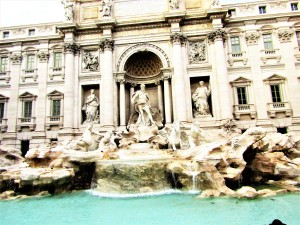
The Trevi Fountain, Rome (of Three Coins in a Fountain, and Anita Ekberg in La Dolce Vita fame). They say if you toss a coin into the fountain then you will be sure to return to Rome. In 1971 I threw a coin in. In 1999 I threw another coin in. So I guess it really works. In 2017 one more coin went in. But I may have to wait on my next life to visit Rome again. I am sure it will still be there.

St. Peters Basilica, Rome. Upon entry into the cathedral it was the first of many times on our tour that Darin’s jaw dropped to the floor. I got to see Michelangelo’s Pieta once again – first time in 1965 at the New York World’s Fair. Still in love with her.
Florence (Firenze), into Renaissance art? This is the place.
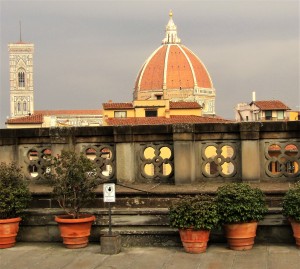
The Duomo, Florence. One of the first great domes. Situated in a great piazza with a beautiful bell tower (seen in the picture) and baptistery. Here seen from a balcony of the Ufizzi Gallery.

Santa Croce Basilica, Florence. The graves of Michelangelo, Galileo, Rossini, Enrico Fermi, Machiavelli, and Dante, et.al. are here. Santa Croce was right around the corner from our AirBnB and we had no idea what was inside. The picture shows Michelangelo’s last resting place.

Michelangelo’s David. An old friend. He was there still waiting for us. This was the second time Darin’s jaw dropped to the floor. I have to admit, mine did too even though I had seen him before.

One of the few Michelangelo’s paintings (aside from the Sistine Chapel), Uffizi Gallery.

Primavera, Botticelli. At the Uffizi.
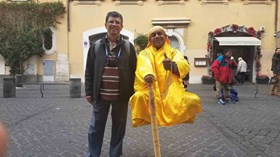
Magic. My magical friend from Bangladesh. I know how this works – but I won’t tell.
Venice (Venezia)
We had train tickets from Florence to Venice. We gave ourselves enough time to get to the station – the taxi stand was just around the corner (no Ubers here). It was raining when we set out to the taxi stand with all our bags. When we get there all there is is a yellow police line. I use my duolingo.com Italian and find out that today is the Florence Marathon. All cars are banned from the city. If all things go smoothly on your journey then you have no stories to tell. Well, we will long tell of our mad 45 minute dash in the rain (me in my crocks). We made it, damper than we had planned for, and even in time to put on a real pair of shoes.

Got $100. Then you can get about a half hour on a gondola. We took the “vaparreto“, the water bus.

Masks for the Venice Carnival
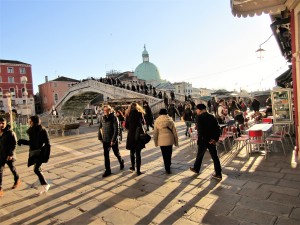
The Rialto Bridge, right outside our hotel.

San Marco, another jaw dropper.
Salzberg
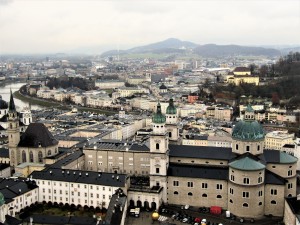

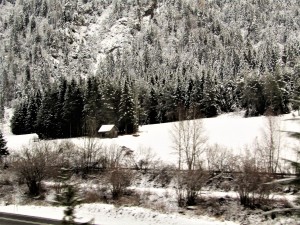
Vienna (Wien)
I get to check off a long held Bucket list item. Darin’s friend Owen, who came to visit us from Paris sat next to an American opera singer on the flight, Rebecca Nelson. She said she had a few tickets to Mozart’s The Magic Flute for tonight, where she would be singing the part of Pamina, daughter of The Queen of the Night. Anybody interested? he asked. Waaa? Yessss! So I checked the “See an Opera in Vienna” item off my bucket list.
And to top it off, we went out with Pamina (Rebecca Nelson) and The Queen of the Night (Beate Ritter) for drinks after the show. The whole tour was Made on that evening. Thanks Owen.

The Magic Flute, Dec 1 2017, Volks Oper (Folk Opera), Wien (Vienna)

Shonbrunn Palace, Vienna, the Hapsburg’s answer to France’s Versailles. Jaws drop again.
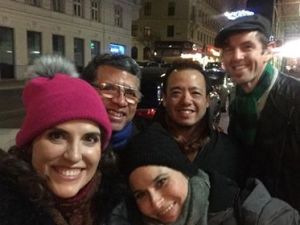
Apre l’opera: With Pamina (Rebecca), and The Queen of the Night (Beate), both of whom did a wonderful job, and behind them there’s Lorenzo the Magnificent, Darin the Navigator, and Owen, the Ticketmaster.
In case you have never heard The queen of the Night aria from The Magic Flute, here is one of the great queens, singing with Pamina. Now pick your jaw up off the floor.
And the grand tour comes to an end after a 30 hour, 4 flight, journey back home. The two highlights of my trip happend in the last few days. Listening to Mozart in Vienna of course, and introducing my son to Mozart; and having the absolutely best hot dog I have ever had, a kaisekrainer (I think – not sure it could have been a bosna, it was dark red and way spicy; there were a dozen different kinds at the sausage stand) at an Austrian Christmas Market.

At a Vienna Christmas Market: In a long life as a hot dog aficionado, this was the best.
Building a House – It Will Cost More Than You Planned For
September 1, 2017
I have written before on Expats buying land and building in Thailand. I have suggested that renting might be the preferred way to go for a number of reasons. A lot depends on your relationships to Thais and Thailand, and how much money you can free up; money that you won’t need for day-to-day living and health care.
(Full disclosure: I have bought and built here in Thailand.)
The biggest problem we Expats face of course, is that foreigners are forbidden to own land in Thailand. So any purchase of land would have to be in a Thai’s name (although there are a few loopholes to these laws). When something you think you own is officially in someone else’s name misunderstandings and trouble often follow. The second is that as we get older it is probably a good idea to have a large part of our cash in liquid form instead of in hard to sell real estate. (My rule of thumb is, Do I have enough cash to pay for a heart bypass operation?) In Thailand many find that buying a property is easy, but when you need the cash, selling, not so much.
If you are like I am, you have lived a life where owning property is what you have dreamed of and striven for most of your life. It is very possibly written into our DNA. I heard someone say once again last week when I broached the idea of renting, “I just feel better when I own something.”
Not sure I agree with that thinking but there is probably no changing that guy’s mind. And there are lots who think the same way. So I thought I might share a bit of experience I have in buying, and building here in Thailand. There are lots of books and posts on buying land and building here, and you should Google all you can.
This post instead, will focus on the hidden and unexpected costs we will incur when building that dream house, or even just a place to lay your weary heads. Not sure I have covered everything but it will at least give you an idea.
Caveat: A lot will depend on if you will be building in a gated community or out in the “real world”. Some gated communities advertise that all you will need is a suitcase to be able to move right in to the house you bought. Much of the following extras I cover below will be incurred if, 1. You decide to change a gated community’s house and garden design specifications, or 2. You decide to buy and build out in the “real world”.
(Full disclosure: I have done both.)
Note: A lot of these costs will be incurred building a house anywhere in the world.
*****
Transfer fees and taxes
Fees and taxes aren’t too high here but how much you will owe will depend on the official estimate of the price of the land you bought and/or the price you paid. The fees and taxes can be paid in three ways. 1. The buyer pays the full amount. 2. The seller pays the full amount. 3. The amount is split with the buyer and seller paying an agreed upon part. This will have to be negotiated before money changes hands.
Architect and blue printing costs
You’ll need to get a building permit from the local land office. To obtain this you will need official blueprints from an architect and inspections will have to be made. Architects can charge you in one of two ways. 1. They will charge using an agreed amount, so much per the square footage of the house. 2. They will charge a lump sum. Again, negotiations will determine this.
The land
When preparing the land for the dream house to be built upon there are a number of costs you will incur above and beyond the price of the land. Some of the following will be included in the builder’s estimate, especially in gated communities. Some not.
Land fill
If you buy low lying land, such as rice field land, you may have to raise it up above flood level, or have it reach the level of the road that passes by. This cost will depend on the type of fill you use; top soil, mountain soil (where nothing much grows), clay, sand, etc. You will be charged by the truck load. Also you will need to hire a tractor or backhoe to spread out and even up the land. The cost will depend on the quality of the land fill and how high you will need to go.
Garden and lawn
Once the land is to the level you need you may have to wait a season or two for it to settle. The longer you have the better and more solid your foundation will be. Then you can start your garden. Trees, flowers, hedges, lawn. How much you spend will depend on the cost of your plantings (houses in gated communities will usually include this in the home price although you may want to modify or add to it). The larger the trees the more expensive. One thing to consider, depending on your age and how long you think you have left to enjoy your plantings, is smaller and less expensive trees will take much longer (sometimes many years) to mature and enjoy (especially fruit trees). A large mature tree can cost 100 times what a seedling would cost. You may have to wait to complete your planting until the house is built but trees and large plantings can go in early.
Wall and gate, automatic gate opener
Almost every house in Thailand, as opposed to say an American house, is surrounded by a large wall. Depending on the safety of your neighborhood (in a gated community, outside in a village, in the countryside, in a large city, etc.). The cost of this wall will depend on the building material, its height, and how large a piece of land you will be surrounding. Then you’ll need a gate and if you want, an automatic gate opener. You can get a very plain gate or one of the fancy “estate” type gates. The costs can differ greatly.
Driveway
Your builder may have added the cost of paving your driveway in the initial estimate, or not. Check carefully. The builder may have given you an estimate for a driveway of simple concrete. You may change your mind and want fancy tiles. Everything will depend on your desires. The cost will of course depend on this.
Garden, gate lighting
For safety and aesthetics, garden lighting is something to consider. You can go with fancy lamps or simple. LED lights or solar powered are good ways to go for the long run as they and will decrease the electricity needs, but the initial costs must be added to your estimate.
Patio and patio furniture, barbecue
You may have included a patio in your design. If you haven’t and decide to build one the cost will be affected. Price will depend a lot on its size, the flooring tiles, (Screen enclosed? Roof covered?). Then it will need to be furnished with patio furniture. You can get simple wooden or plastic furniture or real fancy stuff. Outdoor barbecue? Quite cheap in the west, quite expensive here.
Walkway paving
Your garden may require walkways. Paving stones are good for this but can vary greatly in price. You can install them yourself (almost killed myself doing this) or hire workers.
Water connections
Your land may have city water running right up to it or you may have to pay to get it to you. Another way to go is digging a well (cost will depend on various kinds of wells and the depths you’ll need to go). You can also collect rain water. Because city water can sometimes be sporadic you may also need a large water tank and a pump. See what your neighbors are doing.
Electricity connection, poles
Check to see if the power poles pass right by your house. If they don’t you may have to buy and install these poles and pay for connections. Cost will depend on how far you’ll need to get to the nearest power poles.
Garden tools
Depending on how much gardening you intend doing you’ll need the tools. This can become a considerable cost. There will be things like lawnmowers, weed wackers, shovels, hoes, ladders, saws, axes, hammers, wrenches; the list can go on and on.
The house
Your new house will be empty. Some things like closets, cabinets, and the like may have been included in the builder’s estimate. Some will not.
Windows and doors
Drapes, rods, hangers
These are big items in Thailand and are much needed to protect your house from the sun and peering eyes. Drapes can be simple things, even homemade, hung by the home owner, or very expensive and fancy, professionally installed. Count how many windows you have and the quality of the drapes. Costs can vary considerably.
Door knobs and locks
You need to count the number of doors you have. If you choose to go with doors and door fixtures above and beyond those chosen by the builder, the costs can rise big time. You may also want more secure locks than come with the house.
Bars
Almost all houses in Thailand will have bars on their windows. But new houses often don’t have them and it will be your responsibility to buy and install them if you so desire. If you decide on window and door bars, count your windows and doors and hopefully you won’t be too shocked.
Screens
May or may not be included in the initial cost estimates.
Kitchen
Some of the following will be included in the builder’s estimate, some not. And these are often changed later depending on the home owner’s needs and preferences.
Sinks and faucets (can go really fancy here)
Hot water heater (normal or higher powered)
Counter top (granite, tile, marble, etc.)
Kitchen Island (built in vs. free standing, electricity connected)
Dishwasher (lots of new homeowners choose this way to go)
Cabinets (teak, vinyl, wood, metal built in vs. ready-made)
Refrigerator (normal, side by side, separate freezer)
Microwave
Stove (electric vs.gas, with or without oven)
Bathroom
Thai bathrooms are very simple affairs. Expat bathrooms can be rather elaborate and of course more expensive. Make sure your architect and builder know your needs and preferences.
Faucets (simple to solid gold, yours to choose)
Bathtub (Very few in a Thai home, Expats love them, choose built in or stand-alone)
Hot water heater (like the kitchen you can choose depending on the wattage)
Bedroom
Beds, sheets, pillows, covers (quality decides the cost)
Closets (quite often not included in the house design and in the estimates, built in vs. stand-alone)
Dresser (teak – particle board, and all in between, your choice)
Other
Washing machine (size, with/without dryer)
TV., TV service (70” curved 3D or 24” flat screen, and everything in between, TV service has many prices levels and you may need to buy a satellite dish or get cable connected)
Computer, Internet service (Wi-Fi, boosters, speed)
Carpets, floor covering (few Thai house use carpets, wall-to-wall or otherwise, although straw mats are very popular and comfortable – and smell good too. Expats seem to prefer a softer floor covering especially when they are not used to walking barefoot indoors)
Living room furniture (Thai teak, vinyl, Lazy Boy, Louis XVI, lots to choose from)
Dining room furniture (table for 2 – table for 12)
Bookcases
Wall art
Changing your mind (and the house plan)
How big a change and how often plans change will make a big impact on your costs.
“I know the plan calls for the bathroom to be on the right side but let’s put it on the left.”
“I think we could use a sky light right here.”
“The windows are too small. We need to enlarge them.”
“The porch stairs are on the wrong side. We will need to move them.”
“I don’t like these tiles. Tear them out and use the new ones.”
The above are quotes that I have actually heard (and, now I’m not admitting anything, maybe said myself).
Cost of renting a home while you wait for yours to be finished.
While your home is being built (6 months – a year or more) you’ll need to live somewhere. A lot of us forget this part. Say you go towards the middle and pay 10,000 a month for rent. Six months will be 60,000 baht; a year will be 120,000 baht. Pay more for rent? You do the math. This cost will need to be prepared for.
*****
To conclude, when I remodeled my house back in Seattle (three times), after some experience, I found that I needed to take my initial cost estimate and multiply that number by 1.5 if I were to end up having enough to complete the project. So if I estimated that the work and materials would cost $10,000 I would prepare $15,000. It turns out that that worked out just about right to protect myself from the inevitable shock of seeing the final price.
Buying and building here in Thailand has so many variables (workers’ dependability like leaving for 2 weeks during Songkran or simply not showing up for days at a time, builder working on more than one site at a time and needing to pull workers off your project to work on another, undoing mistakes, redoing changes of mind, rainy season delays, unavailability of the materials you need, your neighbors making legal complaints, inflation in the cost of materials, etc., etc.) It makes it harder to come up with a specific number like I could in Seattle.
But here is a suggestion that worked for me, and I advise anyone thinking of buying and building to talk to as many Expats who have done the same and find out their thinking on this. From my experience it has gone something like:
- Land seller gives me the cost of the land.
- Builder give me his estimate on what the house I am planning on will cost.
- Add the two numbers together, or if buying in a gated community, take the quoted home price.
- Multiply this number by 1.5 if you are building in a gated community, at least by 2 otherwise.
- Now, with this number in mind, you’ll have prepared enough and you won’t die from a heart attack when you add up the final totals. And you’ll survive and be able to take that suitcase and move right into your dream home.
Lots, and lots of luck.
You are What You Wear
August 1, 2017
When I got to the garden party they all knew my name
But no one recognized me, I didn’t look the same
Rick Nelson & The Stone Canyon Band – Garden Party
Most of us are aware that when we retire our lives change, sometimes drastically. And when we retire to a foreign country, the changes can increase exponentially. Some things that are affected by retiring and especially when moving abroad include the language that we speak, the foods we eat, the amount of alcohol we drink, the health care available to us, our circadian rhythms (including when we eat, when we sleep, when we wake, how much we sleep, when we exercise), the religions that influence us, our social relationships including our sex lives, and how we entertain ourselves and spend our leisure time.
I’ll bet that you never thought that you wouldn’t even “look the same”.
If you are like me you’ll be wearing a whole set of different clothes. You may have a picture in your mind of the northern retirees who have moved down to Florida wearing Bermuda shorts (men) and muumuus (women, and some men too). But a move to the tropics will have a much greater impact. You don’t see those white suits and pith helmets and flowing dresses with bustles and large floppy hats like you see in the old movies about the British Raj anymore. But you will look different. Here is how it affected me.


*****
I got shoes you got shoes all of God’s children’s got shoes
When I get to heaven gonna put on my shoes
I’m gonna walk all over God’s heaven
Since retiring to Thailand I haven’t worn a pair of “real” shoes even once. And the pair of leather shoes I shipped here have since disintegrated into a powder. Leather stuff seems to do that here in the tropics.
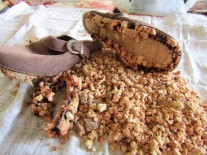
A “good” pair of American shoes after a couple of years in Thailand.
The closest I come to wearing real shoes is occasionally putting on a pair of lace-up running shoes. In the house, everyone here walks barefoot. You take off your shoes before entering a person’s house, or a temple, and sometimes even a shop or someone’s office. Look on the floor in front of a shop or office you are about to enter. If there are shoes lined up in front of the door then you should take your shoes off before entering. When visiting a person’s house ignore anyone who says you don’t need to take your shoes off, especially if they themselves aren’t wearing any.
I see Expats who insist on wearing footwear they were formerly accustomed to. They bend down to untie and later to tie their shoe laces a dozen times a day.
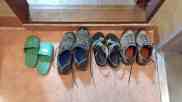
So, because of all this taking-off-of-the-shoes, very few people here will wear lace-up shoes. I wear sandals (with Velcro straps) when I go out to a place where I might meet someone I know (my formal wear). More informally, I wear knock off Crocs when I go to the market. (Note: Real Crocs are sold here for about $30. Knock off Crocs sell for about $2.50). I wear knee-high rubber boots when I work in the garden.  The only lace-up shoes I regularly wear are my golf shoes. It’s also the only time I wear socks. (Note: For some reason Thailand has great socks. Three pair for about $2.50; that is if your feet aren’t too big for them. Mine just about make it.)
The only lace-up shoes I regularly wear are my golf shoes. It’s also the only time I wear socks. (Note: For some reason Thailand has great socks. Three pair for about $2.50; that is if your feet aren’t too big for them. Mine just about make it.)
My suggestion:
When in Rome, wear the same kinds of shoes that everyone else wears.
*****
Pants on Fire
Before moving here I went shopping for dress pants, bought a number of pairs that fit perfectly and shipped them here. They are now hanging in my closet, the tags still on. And I am afraid that the waists nowhere still fit me after 10 years. But no problem. I haven’t worn a real pair of pants since I retired to Thailand.
What I do wear are these ¾ length pants (150 baht) with elastic waists, and occasionally shorts. Although things are slowly changing, it used to be that no adult Thai males would wear short pants. These were reserved for school boys and not for “men”. Women also did not wear shorts. It is still that way for older Thais and I will bet that you have never seen a 70 year old man (whose club I am proudly a member) wearing shorts, except for Expats.
I also wear sweat pants and some warm up type pants with elastic waists. These look like “real” pants but don’t need belts (which I also haven’t worn in years). These are my “formal” pants.
*****
Anthropologists would argue that the tie directs a viewer’s attention downwards to the wearer’s genitals (hence the arrow-like shape). A kind of displaced cod-piece.
Linda Ellerbee (US journalist) is quoted as saying: “If men can run the world, why can’t they stop wearing neckties? How intelligent is it to start the day by tying a noose around your neck?”
I did a search on wearing a dress-shirt and tie on Google and there are lots of opinions about where and why this all started. Above are two of my favorites.
Needless to say I haven’t worn a dress-shirt or tie since arriving here. Before coming we packed all our stuff. All our clothes went into boxes, one of which, after more than 10 years here I opened the other day. In it I found a plastic bag full of my old neckties. I used to have to wear them to work. BTW, I never (unlike a red-tie-wearer we all know) let the tie drop below my belt. Sad!.
I used to be so proud of my ability to tie a perfect Windsor Knot. I think I have lost that ability. But at least I now never have a noose around my neck.

Note: I do own a short-sleeve black dress-shirt. One thing that increases with age is the number of funerals I go to. Sadly, this shirt is getting a lot of wear.
*****
Long Sleeves and Jackets
Although Chiang Mai gets nice and cool in the winter there is rarely much of an opportunity to wear sweaters and jackets. Except that they are on sale just about everywhere. Why is that?
I’ll explain that using a scientific study I once carried out.
I stood on a street corner on a hot afternoon watching the traffic roll by. I counted the number of motorcycles that passed by noting how many riders were wearing long sleeves (shirts, jackets, and sweaters). The results: 95 Thai motorcyclists out of 100 who passed me by on that day were wearing long sleeves. Zero Exapts who drove by were wearing long sleeves.


Why the long sleeves? Well, besides the sun being really hot beating down on bare arms, Thais don’t like dark skin and will do what they can to protect themselves from getting tanned (Just check out the number of TV commercials for whitening cosmetics.) But Expats might consider using long sleeves while riding motorcycles for a more serious reason.
I know a number of my Expat friends who have had to deal with skin cancer here. Usually it is of the non malignant type but they still need to deal with these in a drastic manner. Each has had chunks of tissue cut out from their nose, face, hands and arms.
A helmet will protect you from the sun too, among other reasons for wearing one.
My suggestion:
When in Rome, wear long sleeves when everyone around you is wearing long sleeves.
*****
I should note that Thais occasionally do wear dress pants and shirts and ties and even leather shoes. And there is a bit of history that goes along with this.
Many years ago, along with the first of the Thai constitutions, came a movement to modernize Thai society. This is when the spoon and fork came into popular use, as opposed to simply eating with the fingers (still in vogue in the north and northeast though). Note: chopsticks are Chinese and used mainly with noodle dishes (Chinese) served in a bowl. No Thai would use chopsticks for anything served on a plate unless they were food in little easy-to-pick-up pieces.
People, especially government workers, were required to wear shoes too. When I first came to Thailand I often encountered people, usually villagers, who still walked barefoot. But the flip-flop changed all that. The flip-flop, or thong, may have been one of the most important inventions that have influenced the health of the world’s population (Diseases from going barefoot.) Today I almost never see bare feet except inside the house.
And in Chiang Mai, where ladies going topless was once acceptable, a la the famous topless Balinese at that time (which I was lucky to have encountered), I sometimes came across an older grandma who, on a stifling hot season day, had shed her upper garments (but by that time the younger ladies had made the change to modernity).
Other moves to modernity were the wearing of hats, suits, and ties, and the refraining from chewing beetle-nut.
BTW, It is obvious that women going topless today is severely frowned upon. What isn’t so obvious, especially to Expat men, is that men going topless is also a no-no. Except for an occasional laborer or a farmer out in the field, (and someone on the beach) you will probably not see a Thai male going topless. As for Expats, although it is sometimes difficult to endure, you will see this often.
BTW-2, Expat woman have their own way of dressing, but I try to follow one of the major rules to being a writer: “Write what you know about.” I am only 71 and been married for only 46 years, so I haven’t been around long enough to learn much about women. I will leave the descriptions of how they deal with retirement in the tropics to people who know more than I.
*****
Today I am sitting here at my computer, writing this post barefoot, wearing a tee shirt and 3/4 pants with an elastic waist, possibly unrecognizable to my friends back in the U.S. but as comfortable as I can be.
My suggestion:
When in Rome, if you’re retired and old enough not to care what anyone thinks of you, wear whatever makes you feel good.
Beware the Jabberwock
July 1, 2017
One of the first articles I ever wrote was titled “Cobras in My Garden” (Bangkok Post, circa 1980). I told the story about finding a couple of monocled and venomous slithery friends who had invaded my garden. They didn’t fare very well after an encounter with my garden hoe though. I had chopped one in half (a big no-no I later found out), the head flying off into the bushes. The whole neighborhood screamed at me for being such a fool. About a half hour later their fury was corroborated when the head part, with its fangs flaring and cobra viscera trailing, and still very dangerous, came wiggling out of the shrubbery.
And ever since then I have had to answer the question about how dangerous snakes are in Thailand; the latest being an email telling me that a perspective female retiree to Thailand had decided not to migrate here because she was afraid of the snakes.
Personally, I love snakes. Maybe because of that I see snakes often. Most are harmless and non-venomous. Some are dangerous but sadly all snakes usually run away from me as fast as they can. In fifty years here I have never heard of anyone I know being bitten by either a venomous or non-venomous snake. So are snakes a reason for not coming here? I think my emailer is making a mistake.
Yes, you should be careful if you see a snake although most will be harmless. But there are lots of other things lurking here that, on the danger scale, rank much higher than the 200 or so species of snakes.
Before I get into things to “beware” of, I should emphasize that none of the following “Jaberrwocks” would stop me from a move here.
*****
The tiny danger
The most dangerous animal in Thailand (besides humans that is) is not a snake, or a tiger, or a water buffalo in heat, or a rampaging elephant. All are dangerous, but nowhere near as dangerous as the tiny mosquito.
Dengue fever is a real threat, although for adults it is usually not life threatening. I’ve had it. Painful as hell, worse headache I ever had, 104 temp, lasted about 4 days, but I am still here. It wasn’t much more of a bother for me than a trip to Immigration. Others have had more severe cases.
Children can be hit hard by dengue and recently one of Thailand’s biggest movie stars caught a lethal strain, ended up in a coma and later died. This was a big deal here not only because of the victim being a celebrity but because it is so rare for an adult to die from dengue.
Mosquitoes also carry the much rarer Japanese encephalitis. As the name implies, it attacks the victim’s brain. There is a vaccine for it but unless you are living way out in the boondocks you won’t probably ever see this. It is also known as “sleeping sickness” because many children who get it lapse into a coma which they rarely come out of. I know of only one Expat who contracted Japanese encephalitis. He lived way upcountry and he later had severe psychological issues due to it. Since the Japanese encephalitis mosquito’s life-cycle includes time spent in a pig, if you don’t live near or around pigs then you’ll probably be fine.
And of course there is malaria. I haven’t heard of malaria up here in the north. There is some down in the south though but I have never met an Expat who caught malaria here in Thailand. If a reader knows of someone please let us know, and tell us the story. There are malaria pills but I don’t know anyone here who takes them. It just isn’t a problem that concerns most Expats.
So what does one do about mosquitoes? Screens on your house would be a good idea. I lived in a non-screened house for about 3 years and slept under a mosquito net (When I wasn’t sleeping under a net was when I caught dengue even though the dengue mosquito is most active in the daytime.) There are many insect repellents available here. The best ones use “deet”. Mosquitoes are definitely “repelled” by it, but many people have side effects using it so be careful. There are also mosquito coils which you burn and do keep the little buggers away. But I don’t like breathing in the fumes.
There are also lots of other little buggers that hang around trying to eat us. If you get a scratch or a scrape or break the skin in any way, be sure to quickly wash it out with soap and water and use an antiseptic. You may not be able to see these bacteria but you are now in the tropics and they will find you. A friend of mine almost lost a leg when he got a simple scratch which got infected and it took some serious antibiotics and weeks walking with a cane before the infection was gotten under control.
*****
They’ll eat you out of house and home
Probably the most destructive insects here are the termites. If you have any wood in your house, even door frames, or book cases, or books for that matter, they will find them, and eat them. They won’t physically hurt you but your bank account might get eaten away after paying for house repairs. I have some climate-change-activist friends who tell me that if we don’t stop the destroying of our environment immediately then our species doesn’t have much longer to live on this planet. I hope they are wrong, but if that is the case, then I think the termite will be crowned the new “King of the World”.
*****
There are lots more biters and stingers here who can make life painful and itchy. I’ll just mention the ones I have encountered personally.
The stingers
There are many species of bees in Thailand. The jungle produces lots of illegal honey (which sometimes finds its way into our kitchen), and bee keepers produce a good quality legal kind. We once had a hive of tiny bees living inside the walls of our house. They entered and exited the hive from the outside so we weren’t concerned. Their stings are only bothersome unless you are allergic.
It’s the wasps and hornets that can knock you out with their stings and there is a buzzing, hairy bumble bee whose sting feels like a gun shot. Avoid these guys if you can.
Scorpions are just about everywhere. You’ll often see the large black ones, sometimes frying in a wok in the market as they are considered a delicacy. They are huge and look like black lobsters, but their sting is more or less just a bit of a bother. It is the little red ones that give the big stings. Just turn on the lights, as scorpions are usually photo-phobic, and, like New York roaches, they’ll scurry away.
I can’t fail to mention the one time I was walking through my garden and my arm brushed along the underside of a leaf. POW! I thought I had been bitten by a cobra the pain was so intense. I turned over the leaf and there was this hairy caterpillar looking up and smiling at me. It took hours for the pain to go away. Moral of the story, if it is hairy, stay away.
The biters
You will get bitten by ants, that’s for sure. Little black ones hurt, the big red weaver ants, the ones that make those cool woven nests and whose eggs and larvae are so tasty, can give a painful bite. But it is those tiny red ones, the ones that the Thais call “mot khan fai”, the “ants that itch and burn” that can really hurt.
After a heavy rain ants sometimes like to move house. One rainy season morning I went downstairs, eyes still closed, and stepped right into a moving parade of the “itchy burning ants” going right across my living room floor. They flew up my leg and started biting. I looked down and saw what was happening but it was too late. There was so much pain I thought I was going into cardiac arrest. After getting all the ants off my leg my heart was still racing, my leg felt like it was being cut off, and if I wasn’t flat on my back, and if I had a phone, I would have called 911 (nothing would have happened anyway because emergency here is 191). I survived though, and ever since then, no matter how sleepy I am, I open my eyes wide before going downstairs.
Other biters are centipedes, the big long 8” variety that can put you into the ER (Note: Those huge millipedes are harmless and are in fact good for the garden.); during the rains there are tick invasions, especially in houses with dogs; leeches you’ll discover on your jungle trekking experience; and there are little bugs you can’t even see, like scabies. I caught scabies once in a hill tribe village. Little red dots on the skin, the insect is microscopic, that itched like crazy. Made me feel dirty. If I got them in one night in the village what must it be like for the villagers?
But the bites you want to avoid are from our best friends, dogs. Rabies is endemic to Thailand and a large percentage of the dogs here go unvaccinated and are prone to this virus. If you are bitten or simply scratched by a strange dog then to the doctor you must go and you will probably be in for a series of the rabies vaccine. It is a series of shots over a number of days. They are costly and chances are you wouldn’t even have needed them, but peace of mind sometimes costs a bit. To paraphrase Cercei Lannester, the Mad Queen in Game of Thrones, “If you play the game of rabies, either you get vaccinated, or you die.”
Note on soi dogs or dogs you meet on your walks or runs. They will sound really aggressive but they are just doing what dogs do, protecting their territory. Some people carry sticks or stones with them. That just makes the dogs angrier. Here is what I do. When I pass by a yapping pack of soi dogs, I just stop, arms hanging low, palms out, non-aggressive, and I speak sweetly to them and say, “Please let me pass. I know this is your territory and I promise I won’t do anything to mess it up.” And they quite down, sniff my palms, and then let me go on my way. Amazingly this works almost every time, and I have never been bitten.
*****
So you like it raw?
Do you like sushi and sashimi, raw fish? Live tiny shrimp, still wiggling are favored by many beer drinkers. Lots of people here will eat raw meats including pork. I suggest you go onto YouTube and search for “intestinal parasites pictures”. I would normally put the link here but the sites are not for kids or the squeamish so I’ll let you do it for yourself if you can take it. After seeing them, tell me you still want that nice raw salmon or tuna.
But not to worry. If you cook your foods well and unless you are extremely careless about what you eat, get really drunk often and don’t know what you are eating, or are just addicted to Japanese sashimi, you’ll probably never get a picture of your intestines posted on YouTube. Many old-timers here will do a series of deworming pills once a year as a prophylactic (ask you pharmacist), just as you would for your dog or cat. I used to, but now that I am more careful about what I eat I don’t see the need.
*****
In Nature, it is always a war. Either something (big or small) is trying to eat you, or something is afraid you are trying to eat it and will throw up protection. Because Thailand is in the tropics, is hot, and damp most of the year, and is blessed with so many and varying species of plants and animals, we tend to come into contact with these battles more than if we lived in the more moderate regions of the world (although if my climate-change-activist friends are correct then every place may soon become tropical).
But is that a reason to avoid a retirement here in Thailand? I mean, America has black widow spiders, alligators, rattle snakes, gila monsters, the zika virus, lime disease, its own share of parasites, the Kardashians, Chipolte, and now the U.S. even has dengue fever. I might be afraid of moving THERE.
For some, maybe there are good reasons for avoiding Thailand and the tropics; they simply want to avoid the Jabberwocks. For others, Jabberwocks just make life a little more interesting, and that is one of the reasons I love it here.
*****
If you see a snake and want to ID it, first stay back, and then this link might help.


